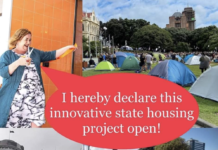The Government’s housing package announced this week doesn’t do enough for families in grave housing stress, nor does it address housing wealth inequality, says the Child Poverty Action Group (CPAG).
“Disappointingly this package ignores the elephant in the room of rampant housing wealth inequality,” says CPAG economics spokesperson Susan St John. “This past year, government policies have fueled the housing wealth divide at an unprecedented rate. Yet this package does not affect the accumulated gains of the well-off, and many will continue to make untaxed gains, particularly as the extension of the brightline test applies only to those houses bought after this weekend.”
While the bright-line extension and the removal of interest deductibility are likely to cool the property market a little, they will not address wealth imbalance. “Those initiatives may scoop off some of the froth, but will not alleviate the financial stress for those renting, let alone house those who are currently homeless,” says St John.
“What is needed is diversion of scarce building resources from high-end housing and renovations to building more state housing. This requires that alternatives to a capital gains tax must be discussed, and untaxed income from housing included in the income tax base to correct perverse market signals.”
CPAG is pleased the Government is taking a multi-pronged approach to infrastructure and land acquisition, but is concerned the package includes no serious attempt to accelerate good-quality state house building and to ensure the resources and expertise are available for this.
CPAG urges the Government to expand its state house building programme, to support community and iwi housing providers to build new houses at scale, and to encourage new forms of private investment in rental housing such as through build-to-rent developments, as well as ensuring better support for whānau and families in government emergency and transitional accommodation, including young people on their own.






This is one way to use everything effectively, but it’ll be tricky – you wouldn’t want to just “leave it to the market” or have certain types in charge. You might inadvertently create a political movement hostile to social progress while housing the victims of a socially hostile political movement. I’m sure they’re already on this, but someone needs to go check to see if Te Pāti Māori are awake. This plan will need their perspective and stabilising effect in increasing doses “as things progress”.
This is not the first time our Maori people have been locked out of housing. I suggest they implement something similar to the Maori Affairs approach they introduced in the 1960s due to the discrimination but without the pepper potting policy.
Comments are closed.